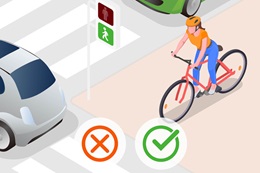Driving Tips
Car Rental Reservations
These are websites for major car rental companies with useful information for driving in Japan. You can also make reservations through the internet or by phone.
Self-serve Gas
SOURCE: Fire and Disaster Management Agency (http://www.fdma.go.jp)
TRANSLATION: Japan Automobile Federation (JAF)
1. Get your gas at filling stations equipped with self-serve pumps!
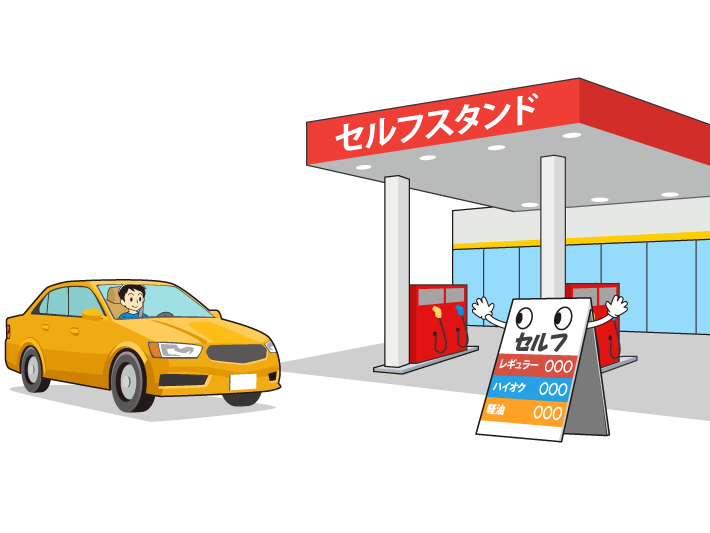
Self-service filling stations have easy-to-see signs at their entrance displaying in Japanese “セルフ” or “セルフサービス”
Self-service filling stations have fixed gas pumps with safety attachments. Some stations also have fuel pumps that are not designed for self-service. Drivers may not use these.
Before refueling
- (1)When entering the self-service filling station, look at the sign to confirm that the fuel pump is for self-serve use and pull up to the pump so that it is easy to refuel, taking care not to hit any equipment.
- (2)Put your car into park and turn off the ignition.
- (3)Unlock the door to the gas tank using the switch in your car.
- (4)Be sure to close the windows and doors when leaving the vehicle.
2. Know and check the proper type of fuel for your car! Make sure to remove all static!
When refueling
- (1)Select the type of fuel for your car. Some cars use gasoline, while others use diesel. It is important for drivers to know the proper type of fuel for their car. This has nothing to do with the size or type of vehicle. Take extra caution when you are refueling a car that you do not normally drive such as the company car or a rent-a-car, or if you are using a self-service station for the first time.
- (2)Be sure to touch the anti-static mat to remove any static that may have accumulated on your body before opening the fuel cap.
If there is no anti-static mat, be sure to remove any static that may have accumulated on your body by touching a metal portion of your vehicle.
- (3)Remove the nozzle for the type of fuel you selected in (1). The type of fuel is labeled near the nozzle (e.g. regular gasoline). If the nozzles or hoses are colored, high octane is always marked in yellow, regular gas is red, and diesel is green.
3. Follow the procedures and do it right!
You may start refueling after the attendant in the control booth has verified safety.
Handle the refueling alone.
Watch that children do not get close to the gas port.
Be sure to follow these instructions when fueling:
- (1)Insert the nozzle securely into the gas port until it fits snugly.
- (2)Pull the trigger on the nozzle until it clicks.
- (3)The gas will automatically stop flowing when it is finished.
- (4)After refueling, be sure to return the nozzle to its original position.
If the self-stopping mechanism activates soon after you begin refueling and you are not able to get gas, consult the attendant for advice on how to fill your tank.
4. Other precautions
- (1) Fire hazards such as lighters and tobacco are strictly prohibited! Gasoline vapor will blow from your gas port as you fill, and any gas drips or spills will cause large amounts of gasoline vapor. Never smoke or use lighters (including the cigarette lighter in your vehicle).
- (2)No subdividing gasoline into containers!
Do not subdivide gasoline into containers by yourself. - (3)Other
Always observe all cautions posted at the self-service station.
What to be careful of on snow-covered and icy roads

When a snow disaster occurs
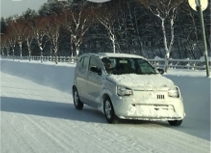
Driving on snow-covered roads
- Be careful on skidding due to sudden lane changes or any other sudden maneuvers.
- Step on the accelerator gradually and start slowly.
- If there is snow on the road, it’s important to put your snow chains on as soon as possible.
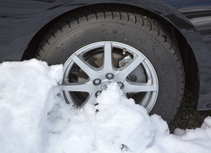
If you get stuck on a snow-covered road
- If your tires skid or get stuck in fresh snow, slowly move the car back and forth tread down the snow around the tires.
- If you find a gravel box at the roadside, scatter the gravel around the driving wheel.
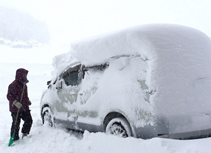
When you get stuck in heavy snowfall and cannot move
- If you’re in a whiteout such as a snowstorm, turn on your hazard lamps and stop at a safe place.
- If the exhaust port is plugged with snow, you are at risk of carbon monoxide poisoning.
- While waiting for rescue to arrive, clear at least enough snow for the exhaust to vent.
Things you should know about snow-covered roads
In addition to using your eyes to maneuver on snowy roads, it is especially important to make predictions. Practice simulations of driving on snowy roads and learn the tips of predicting danger.
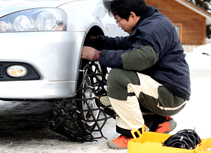
What you want to have before driving on snow-covered roads
- Be sure to have snow chains and a jack, even when your car with snow tires on.
- In the wintertime, you should prepare booster cables for contingencies that may arise.
- Blankets will not only protect you from the cold but also help to escape a snow-covered road.
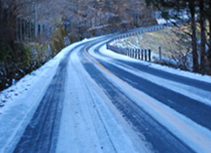
Hazards along snow-covered roads
- Airy bridges and overpasses, and near the inlet and outlet o
- Be especially careful on icy roads, as they are slipperier than snow-covered roads.
- Drive by landmarks such as the arrows and reflector poles along the edge of the road.






